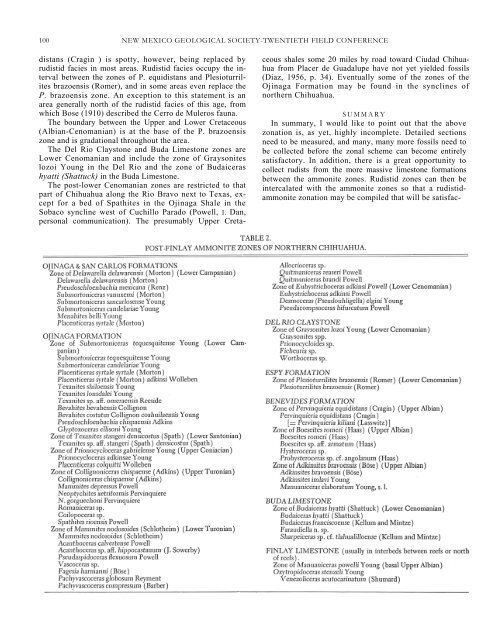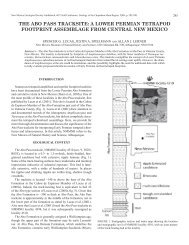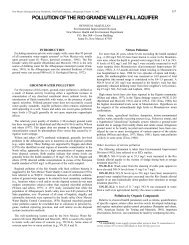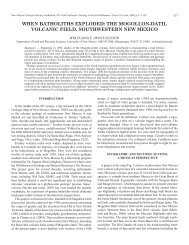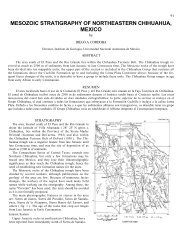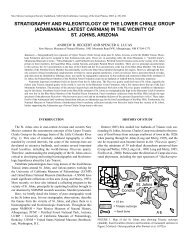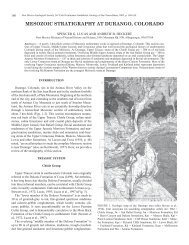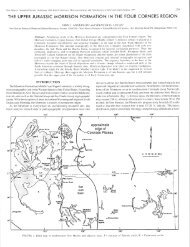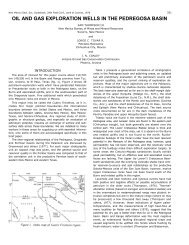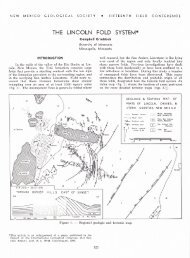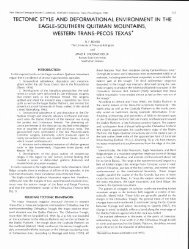100 NEW MEXICO GEOLOGICAL SOCIETY-TWENTIETH FIELD CONFERENCE distans (Cragin ) is spotty, however, being replaced by rudistid facies in most areas. Rudistid facies occupy the interval between the <strong>zones</strong> <strong>of</strong> P. equidistans and Plesioturrilites brazoensis (Romer), and in some areas even replace the P. brazoensis zone. An exception to this statement is an area generally north <strong>of</strong> the rudistid facies <strong>of</strong> this age, from which Bose (1910) described the Cerro de Muleros fauna. The boundary between the Upper and Lower Cretaceous (Albian-Cenomanian) is at the base <strong>of</strong> the P. brazoensis zone and is gradational throughout the area. The Del Rio Claystone and Buda Limestone <strong>zones</strong> are Lower Cenomanian and include the zone <strong>of</strong> Graysonites lozoi Young in the Del Rio and the zone <strong>of</strong> Budaiceras hyatti (Shattuck) in the Buda Limestone. The post-lower Cenomanian <strong>zones</strong> are restricted to that part <strong>of</strong> <strong>Chihuahua</strong> along the Rio Bravo next to Texas, except for a bed <strong>of</strong> Spathites in the Ojinaga Shale in the Sobaco syncline west <strong>of</strong> Cuchillo Parado (Powell, I. Dan, personal communication). The presumably Upper Creta- ceous shales some 20 miles by road toward Ciudad <strong>Chihuahua</strong> from Placer de Guadalupe have not yet yielded fossils (Diaz, 1956, p. 34). Eventually some <strong>of</strong> the <strong>zones</strong> <strong>of</strong> the Ojinaga Formation may be found in the synclines <strong>of</strong> <strong>northern</strong> <strong>Chihuahua</strong>. SUMMARY In summary, I would like to point out that the above zonation is, as yet, highly incomplete. Detailed sections need to be measured, and many, many more fossils need to be collected before the zonal scheme can become entirely satisfactory. In addition, there is a great opportunity to collect rudists from the more massive limestone formations between the ammonite <strong>zones</strong>. Rudistid <strong>zones</strong> can then be intercalated with the ammonite <strong>zones</strong> so that a rudistidammonite zonation may be compiled that will be satisfac-
NEW MEXICO GEOLOGICAL SOCIETY-TWENTIETH FIELD CONFERENCE 101 tory for the entire <strong>northern</strong> <strong>Chihuahua</strong> area and adjacent Trans-Pecos Texas. The zonation presented here is the most reasonable for the present data, but can easily be altered with future data and more time. REFERENCES Bose, Emil, 1910, Monografia geolOgica y paleontológia del Cerro de Muleros circa de cuidad Juarez, Estado de <strong>Chihuahua</strong> y descripcion de la fauna Cretácea de la Encantada, Placer de Guadalupe, Estado de <strong>Chihuahua</strong>, <strong>Mexico</strong>: Inst. Geol. <strong>Mexico</strong> Bol., no. 25, vi + 193 pp., 48 pls., + maps and cross-sections. Bridges, L. W., 1962, Geology <strong>of</strong> Mina Plumosas Area, <strong>Chihuahua</strong>, <strong>Mexico</strong>: Univ. <strong>of</strong> Texas, dissertation, 241 pp., + appendix, 34 figs., 3 pls., 11 tbls. , 1965, Geologia del Area de Plomosas, <strong>Chihuahua</strong>: pp. 1- 134, figs. 1-21, maps 1-3, tbls. 1-11, in BRIDGES, L. W., & ZOLTAN DE CSERNA, Estudios Geológicos en el Estado de <strong>Chihuahua</strong>: Inst. Geol. <strong>Mexico</strong> Bol., no. 74, 148 pp., il. [translated by Diego A. Cordoba]. Burckhardt, Carlos, 1930, etude synthetique sur le Mesozoique Mexicain: Soc. PaMont. Suisse, Mem., v. 49 & 50, 280 pp., il. Campbell, D. H., 1968, Petrology <strong>of</strong> the Early Cretaceous Yucca Formation, Southern Quitman Mountains and Vicinity, Trans- Pecos Texas: Texas A&M Univ., dissertation, xvi 323 pp., 16 figs., 11 pls. Casey, Raymond, 1961, The Stratigraphical Paleontology <strong>of</strong> the Lower Greensand: Paleontology, v. 3, pp. 487-621, 14 text figs., pls. 77-84. Diaz, Teodoro, 1956, Ruta: Cuidad Juarez, <strong>Chihuahua</strong>, Chih.: pp. 23-32, 4 figs., in DIAZ, TEODORO, ET AL., Estratigrafia Mesozoica y Tectónica de la Sierra de <strong>Chihuahua</strong>: Pérmico de Placer de Guadalupe, Chih.: Geohidrologia de la Region Lagunera: Estratigrafia Mesozoica y Tectónica de la Sierra Madre Oriental entre Mapimi, Dgo. y Monterrey, N. L.: Congreso Geol. Internacional, Excursion A-13, 120 pp., il. Gillerman, Elliot, 1958, Geology <strong>of</strong> the Central Peloncillo Mountains, Hidalgo County, <strong>New</strong> <strong>Mexico</strong>, and Cochise County, Arizona: <strong>New</strong> <strong>Mexico</strong> Bur. <strong>of</strong> Mines and Mineral Resources, Bull. 57, 152 pp., 1 fig., 14 pls., 2 tbls. Haenggi, Walter T., 1966, Geology <strong>of</strong> El Cuervo Area, Northeastern <strong>Chihuahua</strong>, <strong>Mexico</strong>: University <strong>of</strong> Texas dissertation, 401 pp., 37 figs., 7 pls., 22 tbls. Hyatt, Alpheus, 1903, Pseudoceratites <strong>of</strong> the Cretaceous: U.S. Geol. Survey, Monograph 44, 351 pp., 47 pls. (ed. by T. W. Stanton ). Imlay, Ralph W., 1938, <strong>Ammonite</strong>s <strong>of</strong> the Taraises Formation <strong>of</strong> Northern <strong>Mexico</strong>: Geol. Soc. Am., Bull. v. 49, pp. 539-602, 4 figs., 15 pls. , 1940, Neocomian Faunas <strong>of</strong> Northern <strong>Mexico</strong>: Geol. Soc. Am. Bull., v. 51, pp. 117-190, 7 figs., 21 pls. , 1943, Upper Jurassic <strong>Ammonite</strong>s from the Placer de Guadalupe District, <strong>Chihuahua</strong>, <strong>Mexico</strong>: Jour. Paleo., vol. 17, pp. 527-654, 1 text fig., pls. 87-95. Jones, B. R., 1968, Geology <strong>of</strong> the Southern Quitman Mountains and vicinity, Hudspeth County, Texas: Texas A&M Univ., dissertation, 162 pp., il. Powell, J. Dan, 1963a, Cenomanian-Turonian (Cretaceous) <strong>Ammonite</strong>s from Trans-Pecos Texas and northeastern <strong>Chihuahua</strong>, <strong>Mexico</strong>: Jour. Paleontology, v. 37, pp. 309-322, 3 figs., pls. 31-34. , 1963b, Turonian (Cretaceous) <strong>Ammonite</strong>s from northeastern <strong>Chihuahua</strong>, <strong>Mexico</strong>: Jour. Paleontology, v. 37, pp. 1217- 1232, 6 text-figs., pls., 166-171. Ramirez, M. Jaime C., and Francisco Acevedo C., 1957, Notas Sobre la Geologia de <strong>Chihuahua</strong>: Assoc. Mexicana de Geológos Petroleros, v. 9, pp. 583-770, 61 figs., 7 tbls., 6 strat. columns. Scott, Gayle, 1940, Cephalopods from the Cretaceous Trinity Group <strong>of</strong> the south-central United States: The Univ. <strong>of</strong> Texas Publ. 3945, pp. 969-1125, figs. 138-179, pls. 55-68. Stoyanow, Alexander, 1949, Lower Cretaceous Stratigraphy in southeastern Arizona: Geol. Soc. Am. Memoir 38, 169 pp., 27 pls., 7 tbls. Wolleben, J. A., 1967, Senonian (Cretaceous) Mollusca from Trans- Pecos Texas and northeastern <strong>Chihuahua</strong>, <strong>Mexico</strong>: Jour. Paleontology, v.41, pp. 1150-1165, 8 text figs., pls. 147-152. Young, Keith, 1966a, Relict Lyellicerid Fauna <strong>of</strong> Texas and Northern <strong>Mexico</strong>: Program, Am. Assoc. Petro. Geol., 51st Ann Meeting, p. 116. , 1966b, Texas Mojsisovicziinae (Ammonoidea ) and the zonation <strong>of</strong> the Fredericksburg: Geol. Soc. Am. Memoir 100, viii + 225 pp., 21 figs., 38 pls., 5 tbls. , 1968, Upper Albian (Cretaceous, M. romeri zone) am- monites in Texas and <strong>Mexico</strong>: Jour. Paleontology, v. 42, pp. 70-80, 1 text fig., pls., 15-19. , 1969, Comanchean Barrier Reefs and Endemism <strong>of</strong> Co- manchean Faunas: Carribean Geol. Assoc., 21 pp., 4 figs., 2 tbls. [in press].


